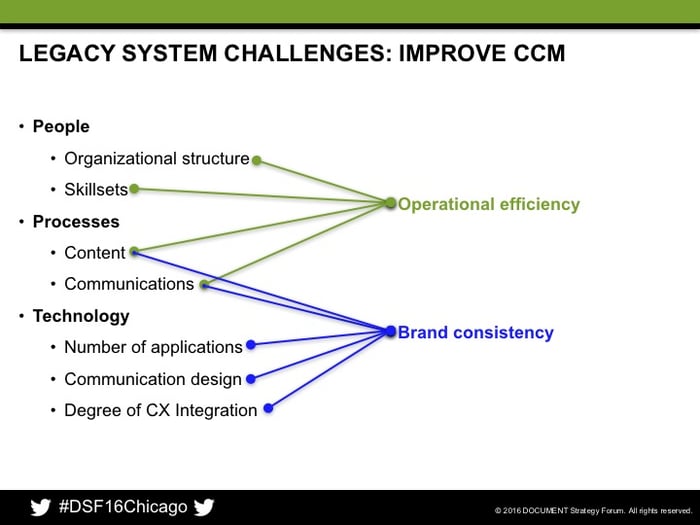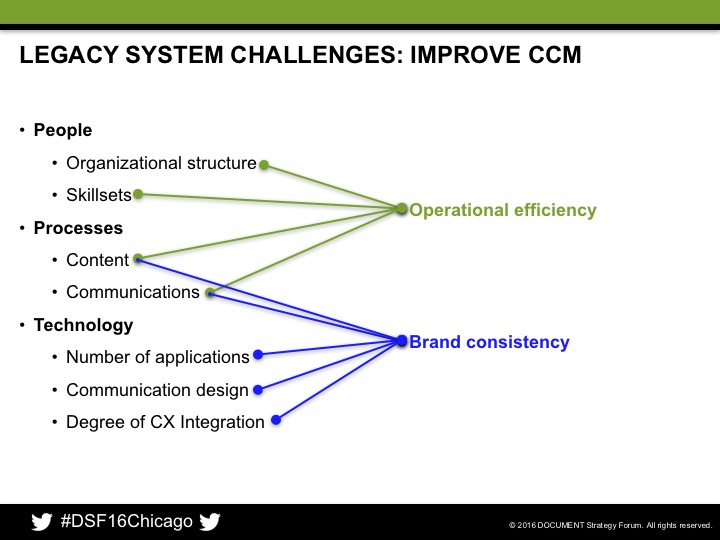Legacy Systems Challenge Your Digital Customer Experience
Unless you’re a brand-spanking-new startup, your organization almost certainly has legacy software. By “legacy,” we mean previously acquired and now outdated – any software that was purchased when business requirements and market dynamics were different than they are today.
I’ve seen several reliable sources throw out numbers for the percentage of the average IT department’s budget that is dedicated to maintaining legacy systems, and they’re all around this number: 80%. Think about that for a moment. How is your company supposed to adapt to disruptive change – change that’s happening more rapidly all the time; change that’s more fundamental and pervasive – when 80% of the IT budget is going to maintaining software that was never intended to deal with recent changes, much less what’s coming next?
Hence, the “challenge” portion of this article’s title. How are you going to face the difficult tasks and problems related to modernizing your customer communications while you’re dragging along as many as 27 different legacy composition tools? (Don’t laugh – I didn’t make that number up. There’s a financial services firm you’ve all heard of that actually has – today – 27 different composition tools under their roof. Talk about challenges!)
Addressing People, Processes and Technology
Based on my experience, and in speaking with well over 100 analysts in the last 18 months or so about customer communications and customer experience, the most common challenges facing companies trying to move toward more of a digital footprint all revolve around these three topics: people, processes, and technology. You need to address them in that order, which means dealing with technology last (and yes, I work for a technology company).

A slide from my presentation at Document Strategy Forum 2016
People: Focus on your organizational structure and your employees’ skill sets. If you’re in customer communications management (CCM), overall company culture might be outside your purview, but most enterprises have a customer experience initiative or a senior executive in charge of it. You may be able to change how the employees in various departments work together, or you might be able to share your subject matter expertise outside of your own department (think: center of excellence).
Processes: Since we’re talking about legacy systems, think about how you create and manage content and communications. Are you re-creating content across departments, or are you sharing a common library of content? We’re talking not just about granular assets like images and reusable content objects, but also the bigger components like stylesheets, layouts and templates.
Technology: And finally, technology. Are you able to design a communication in one system but deliver it through another? For example, could you design a piece of correspondence, and then have it delivered via your marketing automation system as an email so it can be tracked and reported on? Do you have the right tools in place to enable that kind of content and communication sharing? How about even the review and approvals that cross departmental – or even organizational – lines? Because when you have 27 different composition systems, and a marketing automation system, and a bunch of other systems all creating and distributing content to the same recipients… how consistent is your brand across those channels and communications? Do the communications look and feel like they’re coming from the same company? If your CCM solutions aren’t integrated with the rest of your digital experience delivery architecture, if they’re still operating in silos, then how will you ever achieve CX integration?
When it comes to technology, remember that 80% number I mentioned earlier. Most companies simply do not have the budget or bandwidth to make radical changes or "rip and replace" systems. Companies that are well into their digital transformations have generally taken an incremental approach, rather than undertaken a comprehensive overhaul (and that’s not a bad thing).
What You Can Do Right Now
Forrester’s Customer Experience Index has proven that customer communications is one of the few “universal drivers” of customer experience. The quality of customer communications affects the customer experience for every industry. I’m calling attention to this point because it has nothing to do with technology. You can make improvements to your customer communications from within your legacy systems.
For example, focus on the language you use – how clear and understandable each communication is. By helping customers understand more easily what they should do and how they should do it, you can deflect calls and reduce call center volumes. If they do call, you can improve first call resolution rates. You can affect customer satisfaction and Net Promoter Scores – all by improving what you say and how you say it, before having to buy any new software.
If you’re working in a legacy composition system, you likely have two other challenges related to content:
- Your layouts and templates are likely saved in a proprietary file format that can’t be shared easily, if at all, with other systems.
- The composition tool probably has a “page” or “document”, rather than a channel-agnostic orientation.
Luckily, lots of legacy composition tools use Microsoft Word as a composition tool. You can easily export reusable content objects out of Word for use in other systems. But the templates and business rules are likely locked in the legacy system and will have to be re-created in any replacement system.
If you do make the decision to consolidate composition tools, look for one that uses an open file format like HTML5 or JSON (an XML variant) that is – or can be made to be – channel-agnostic. That makes it far more likely that you’ll be able to share your content with the other customer communication components in your digital experience architecture.
Do you have questions about other ways to improve your CCM or need advice about creating a transition plan to move from legacy CCM and CX software to next-generation solutions? Drop us a line. We’re always happy to help.







